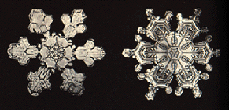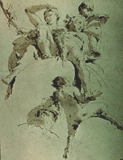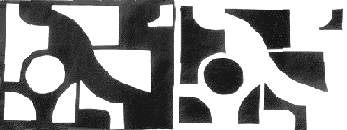

There are various ways to categorize form and shape. Form and shape can be thought of as either two dimensional or three dimensional. Two dimensional form has width and height. It can also create the illusion of three dimension objects. Three dimensional shape has depth as well as width and height.
Form and shape can also be described as either organic or geometric. Organic forms such as these snow-covered boulders typically are irregular in outline, and often asymmetrical. Organic forms are most often thought of as naturally occurring.
 Geometric forms are those which correspond to named regular shapes, such as
squares, rectangles, circles, cubes, spheres, cones, and other regular forms.
Architecture, such as this example by Frank Lloyd Wright, is usually composed
of geometric forms. These forms are most often thought of as constructed or
made. If you are interested in the visual possibilities of geometric forms,
take a look at an index to
images of mathematical origami, you might wish to look at this Web site,
or at least at these
mathematically generated forms.
Geometric forms are those which correspond to named regular shapes, such as
squares, rectangles, circles, cubes, spheres, cones, and other regular forms.
Architecture, such as this example by Frank Lloyd Wright, is usually composed
of geometric forms. These forms are most often thought of as constructed or
made. If you are interested in the visual possibilities of geometric forms,
take a look at an index to
images of mathematical origami, you might wish to look at this Web site,
or at least at these
mathematically generated forms.
However, not all made objects are geometric; many designed forms
have irregular contours. Although this kimono is geometric in its construction, the surface design is organic in form.
 Nor are all naturally occurring objects organic; snowflakes and soap bubbles
are among many geometric forms found in nature. If you are interested seeing
other visual examples of geometry in nature, you might enjoy looking at this
site, in which patterns found in nature
,are explored.
Nor are all naturally occurring objects organic; snowflakes and soap bubbles
are among many geometric forms found in nature. If you are interested seeing
other visual examples of geometry in nature, you might enjoy looking at this
site, in which patterns found in nature
,are explored.
There are some other terms commonly used to describe form and shape in composition; these have to do with what kind of representations the forms have. If we can recognize every day objects and environments, we refer to the images as being realistic, or naturalistic. However, if the images are difficult or impossible to identify in terms of our normal, daily visual experience, we may refer to the images as abstract.
There are several kinds of abstract images. Generally, abstractions are "abstracted" or derived from realistic images - perhaps even distorted--, but perhaps in such a way that the source is not immediately apparent. An example of this would be one of Georgia O'keefe's paintings of a detail from a flower. This kind of abstraction in art is sometimes referred to as an objective image -- that is, it is derived from an actual object. On the other hand, some abstract art images are based on a pure study of form, line, and color, and do not refer to any real-world object or scene. such art works are sometimes referred to as non-objective images.
Charicature is a special instance of abstraction, in which realistic images are distorted to make a statement about the people, places, or objects portrayed. This is probably the kind of abstraction we are most familiar with, as it is constantly presented to us via all sorts of popular media. However, it is important to remember that had not the more difficult-to-understand conventions of abstraction in the fine arts not broken ground with experiments in distortion, we would not be able to make sense out of some charicature images. A century ago, there was really nothing equivalent to our modern cartoons.
Our perception of shape and form are affected by several factors. The position or viewpoint from which we see an object will emphasize or obscure certain features, and therefore affect the impression it makes. As you can see in this series of photographs, all featuring the same wooden artist's mannequin, the character of the space around the object can distract, focus, or alter our impression. A cluttered background tends to diminish the importance of the object, while a plain background draws attention to it.
The character and source of light also changes the perceived character of the object. Lighting in a photographic portrait, for example, can make the subject look older, younger, dramatic, or rather abstract.
 It can be defined by line, in all the ways described above.
Line, either explicit or implied, provides the contour of forms.
It can be defined by line, in all the ways described above.
Line, either explicit or implied, provides the contour of forms.
Value (the relative lightness or darkness of a color) can also define form. Strong contrasts in value within a composition may define the boundaries of forms. Gradations of value, or shading, can also create the illusion of contour and volume.
In the same way, hue contrasts and gradations can
also define forms. Form may also be defined by change in texture, even when hue and value remain essentially consistent. However, most typically, form is defined by a combination of these factors, as is the case in this print by Max Ernst.
 Forms and shapes can be thought of as positive or negative.
In a two dimensional composition, the objects constitute the positive forms,
while the background is the negative space. For beginning art and design students,
effective use of negative space is often an especially important concept to
be mastered. This exercise in cut paper required the student to work with the
same composition in black on white and white on black simultaneously. This makes
it difficult to ignore the background and treat it as merely empty space. The
effective placement of objects in relation to the surrounding negative space
is essential for success in composition.
Forms and shapes can be thought of as positive or negative.
In a two dimensional composition, the objects constitute the positive forms,
while the background is the negative space. For beginning art and design students,
effective use of negative space is often an especially important concept to
be mastered. This exercise in cut paper required the student to work with the
same composition in black on white and white on black simultaneously. This makes
it difficult to ignore the background and treat it as merely empty space. The
effective placement of objects in relation to the surrounding negative space
is essential for success in composition.
Some artists play with the reversal of positive and negative space to create complex illusions. The prints of M. C. Escher (click on Picture Gallery, then Symmetry) often feature interlocking images that play with our perception of what is foreground and what is background. Other artists take these illusions of positive and negative images to even greater lengths, hiding images within images. Perception of form and shape are conditioned by our ingrained "instinct" to impute meaning and order to visual data. When we look at an image and initially form an impression, there is a tendency to latch on to that conclusion about its meaning, and then ignore other possible solutions. This may make it hard to see the other images. Training the eye to keep on looking beyond first impressions is a crucial step in developing true visual literacy.
| |
 |